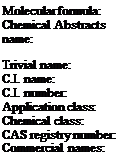Dyes are named either by their commercial trade name or by their Colour Index (C. I.) name. In the Colour Index [5] these are cross-referenced.
The commercial names of dyes are usually made up of three parts. The first is a trademark used by the particular manufacturer to designate both the manufacturer and the class of dye, the second is the color, and the third is a series of letters and numbers used as a code by the manufacturer to define more precisely the hue and also to indicate important properties of the dye. The code letters used by different manufacturers are not standardized. The most common letters used to designate hue are R for reddish, B for bluish, and G for greenish shades. Some of the more important letters used to denote the dyeings and fastness properties of dyes are W for washfastness and E for exhaust dyes. For solvent and disperse dyes, the heatfastness of the dye is denoted by letters A, B, C, or D, A being the lowest level of heatfastness, and D the highest. In reactive dyes for cotton, M denotes a warm — (ca 40 °C) dyeing dye, and H a hot-dyeing (ca 80 °C) dye.
There are instances in which one manufacturer may designate a bluish red dye as Red 4B and another manufacturer uses Violet 2R for the same dye. To resolve such a problem the manufacturers’ pattern leaflets should be consulted.
These show actual dyed pieces of cloth (or other substrate) so the colors of the dyes in question can be compared directly in the actual application. Alternatively, colors can be specified in terms of color space coordinates. In the CIELAB system, which is is becoming the standard, the color of a dye is defined by L, a, and b coordinates.
The C. I. (Colour Index) name for a dye is derived from the application class to which the dye belongs, the color or hue of the dye and a sequential number, e. g., C. I. Acid Yellow 3, C. I. Acid Red 266, C. I. Basic Blue 41 , and C. I. Vat Black 7. A five digit C. I. (Constitution) number is assigned to a dye when its chemical structure has been disclosed by the manufacturer. The following example illustrates these points:

 |
C33H 20O 4
16,17-dimethoxydinaphtho l[1,2,3-cd:3 ‘,2’,1
lm]perylene-5,10-dione
jade green
C. I. Vat Green 1
C. I. 59825
vat
anthraquinone
[125-55-5]
Solanthrene Green XBN, AVECIA Cibanone Brilliant Green, BF, 2BF, BFD, CIBA-GEIGY Indanthrene Brilliant Green, B, FB
It is important to recognise that although a dye has a C. I. number, the purity and precise chemical constitution will vary depending upon the name. Thus, the dye C. I. Direct Blue 99 from company A will not be identical to C. I. Direct Blue 99 from Company B.
 17 августа, 2015
17 августа, 2015  Pokraskin
Pokraskin  Опубликовано в рубрике
Опубликовано в рубрике 